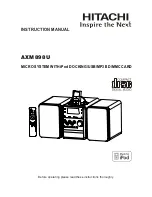
8.3.2 Gain
The microphone signals are amplified by an Amplifier A4 with 40dB of gain
followed by an Amplifier A3 with 20dB of gain.
8.3.3 Studio Talkback, ‘Normal’
The Studio Talkback Normal button PB1 when operated connects the output
of the Amplifier A3 (B9) through a 10k
Ω
mixing resistor R102 to VR9 and R107 in
series. Normally signal is taken from the common point of these amplifiers by
another 20dB Amplifier A3 (B21) to K3 which, in its central position marked Studio
LS, passes the signal to the Studio Talkback Normal level control VR4 the slider of
which feeds the A inputs of the Amplifiers N in the Studio loudspeaker chain.
A further make contact on PB1 operates active relay RL2 to quiet the control
room loudspeakers and also operates active relay RL4 to switch the Amplifier N
from their normal inputs to their A inputs.
8.3.4 Studio Talkback, ‘Loud’
Pressing this button transfers the input of Amplifier A3 (B21) from the lower
end of VR9 to the slider thereof. According to the setting of this control up to 10dB
more gain will be introduced when the loud button is pressed. VR4 (Normal) and
VR9 (Loud) are screwdriver adjustable controls located just in front of the respective
buttons.
In order to obtain the loud condition the ‘normal’ and ‘loud’ buttons must
both be pressed.
8.3.5 Artist Manager’s Microphone
This is a hand microphone of 25
Ω
impedance and is provided with a “press
to speak” switch. When pressed this switch removes a short circuit from the output
and closes an independent pair of contacts. A screened quad lead is provided with
a miniature Tuchel 6-pin plug for insertion into SK8 on the rear of the cassette.
8.3.6 A.M. Gain
The microphone output is adjusted by a level control VR5 which has a
screwdriver slot and has a range of about 20dB. This is followed by a 40dB
Amplifier A4. As this microphone is normally held close to the mouth its output is
much greater than that of the operator’s microphone so less gain is provided.
8.3.7 A.M. Mixing
With the Artist Manager selector switch at Talkback, signal is mixed with that
from the operator’s circuit through another 10k
Ω
resistor R101. R103 and R104 are
included at the input ends of the mixing resistors to reduce the change of gain
through one channel which is caused by switching on the other channel. To
minimise this effect these resistors should be equal to the output impedance of an
Amplifier A, but this would low-load the amplifier output. The value chosen is a
compromise. From this point at which the signals are mixed the operator and the
















































